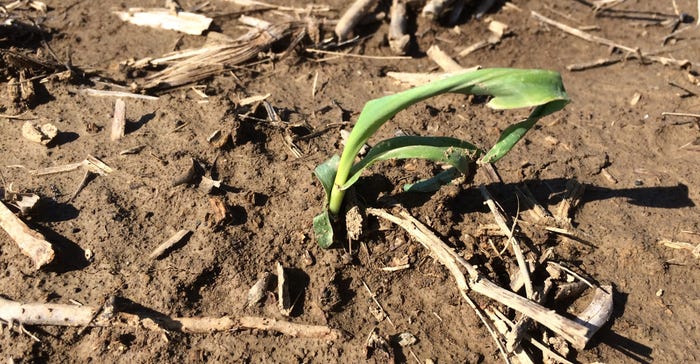May 30, 2018

By Bob Hartzler and Meaghan Anderson
Cool conditions during the 2018 planting season increased the potential for herbicide injury to corn seedlings due to slow emergence and reduced ability of the crop to metabolize herbicides. While herbicides may be responsible for emergence issues, most of the problems this spring seem to be primarily due to environmental conditions rather than the herbicide.
A symptom associated with Group 15 herbicides is improper unfurling of leaves as corn emerges from the soil. This injury is less frequent now than in the past, since many of these products now include safeners. Also, the availability of effective postmergence herbicides has resulted in many growers reducing application rates.
Improper unfurling of corn leaves has been attributed to other phenomena as well, including cloddy soils, compaction or soil crusting, cool and wet soils, and wide fluctuations in soil temperature.
Poor emergence
A field in southeast Iowa this spring exhibited symptoms of improper unfurling of leaves on corn plants. The injury had no apparent pattern, affecting plants at random and accounting for about 5% to 10% of the total stand. Some plants were twisted or in a corkscrew shape underground, while others were buggy-whipped at the soil surface.
The cornfield was planted April 24 and sprayed with 2.8 quarts per acre of Harness Xtra 5.6L on April 28. Following planting, nighttime low temperatures remained cool until early May, but daytime temperatures reached highs in the 70s or 80s. Planting depth varied quite widely across the field, with some seed planted more than 2.5 inches in the ground and other seed at less than 1-inch depth.
Prior to noticing symptoms, the farmer also rotary hoed this field as is his standard practice in spring. This resulted in some emerged seedlings being reburied in the soil.
Abnormal growth of corn seedlings often is caused by a combination of stresses, and in many cases its difficult, if not impossible, to identify which factor is the primary culprit. While we can’t rule out the possibility that the herbicide played a role in the issue in this field, we suspect the environment along with management practices were the leading factors involved in the emergence problems.
Herbicide carryover
An additional stressor in this particular field was the presence of fomesafen herbicide carryover injury. Flexstar and other fomesafen herbicides can cause veinal necrosis on corn leaves, and the damage to the mid-vein often causes early leaves to “collapse.”
These veinal necrosis symptoms were only evident at the entry of the field, indicating that the carryover likely was due to overapplication of the herbicide in this part of the field. Due to the lack of fomesafen symptoms in other areas of the field, it is unlikely that fomesafen contributed to the improper unfurling seen throughout the field.
There have been numerous reports of fomesafen herbicide injury to corn recently in Iowa. Since fomesafen is broken down more quickly with wetter soil conditions, some injury following last summer’s dry weather is not surprising to see this spring in spray overlap areas or where a heavier rate of the herbicide was applied. Experience suggests the corn will rapidly grow through this injury, but there always are exceptions.
The increased use of rescue treatments made into July to control waterhemp is the primary factor leading to these problems. There is a 10-month rotation restriction for corn following fomesafen use, so the product shouldn’t be used in July in most situations. The inclusion of residual herbicides (group 15 products) with early-postemergence application or planting narrow-row soybeans are the simplest strategies to limit the need for rescue treatments.
Seedling diseases attack young corn
Corn in a field in southwest Iowa emerged normally but then began to rot from within the whorl following a heavy rain. The damage was spotty throughout the field, but where it was present, 5% to 10% of the plants were affected. Since no herbicides had been applied yet (not a recommended practice), there were questions whether the rain could have splashed residues from the previous year’s product into the whorl of the corn plants this spring. Based on the herbicides used during 2017 in this field, it was easy to rule this out.
So, what was the problem? Nearly all the dying corn plants had significant quantities of soil inside the whorl. The likely cause of death was bacterial infection due to the soil washed into the whorl.
The majority of the preemergence herbicides applied to fields achieve selectivity based on differential metabolism; the crop detoxifies the herbicide more quickly than sensitive weeds can do it. Any situation (shallow planting, heavy rain, misapplication) that increases the amount of herbicide in contact with the seed while it imbibes water increases the likelihood of injury.
Cool or fluctuating temperatures can also reduce the crop’s ability to metabolize the herbicide. There are always risks when using herbicides, but the advantages they provide in managing weeds greatly outweigh these risks.
Hartzler is a professor of agronomy and an Extension weed specialist at Iowa State University. Anderson is an ISU Extension field agronomist in east central Iowa.
You May Also Like




